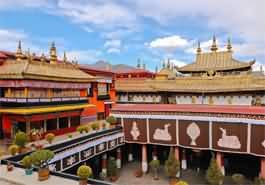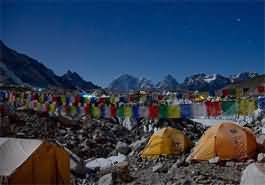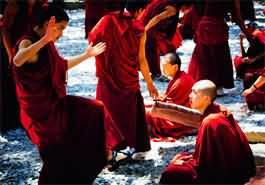As one of the highest cities in the world at an altitude of 3,490 metres (11,450 ft), Lhasa has many wondrous and culturally significant sites. As the capital of Tibet - Lhasa is the home of the magnificent Potala Palace and Jokhang Temple where pious pilgrims prostrate themselves and grand snowy mountains rise toward the sky.
 The famous Potala Palace is the symbol of Tibet and a dream for many people to visit. This 13-storyed building is over 1,300 years and was once the winter residence for Dalai Lama and the seat of Tibetan Government. It sits towering on the 130-m Red Hill (Marpo Ri) in northwest Lhasa.
The famous Potala Palace is the symbol of Tibet and a dream for many people to visit. This 13-storyed building is over 1,300 years and was once the winter residence for Dalai Lama and the seat of Tibetan Government. It sits towering on the 130-m Red Hill (Marpo Ri) in northwest Lhasa.
The palace is like a pearl on the roof of the world and houses abundant relics, Tibetan crafts and is a unique Tibetan cultural heritage. History says that the palace was built in 7th centruy AD to strengthen the political power of Srongtsen Gampo and to help defend against foreign invasion. However people like the story that Potala Palace was constructed for Princess Wencheng as a gift from Strongtsen Gampo.
The Potala Palace consists of White Palace which was living quarters for the Dalai Lama and Red Palace in the center for religious uses. The Red Palace contains beautifull and mysterious chapels which contain several tombs of Dalai Lamas. The White Palace provides a deeper sight into Dalai Lamas’ life in the palace. Photos are prohibited inside.
This unique experience requires visitors to climb some steep stairs. Visiting time is limited to 1 hour. Visitors have to buy tickets the day before the visit using ID or passports. A small hill opposite the palace offers great photo opportunities. It cost 2 Yuan/person to go up the small hill.
 Situated in the west of Lhasa, Norbulingka is known as the Summer Palace in Tibet and the name reflects its beauty and magnificence. Construction began in the 18th century during the 7th Dalai Lama period and became the summer residence for Dalai Lamas while handling affairs of state and for religious activities.
Situated in the west of Lhasa, Norbulingka is known as the Summer Palace in Tibet and the name reflects its beauty and magnificence. Construction began in the 18th century during the 7th Dalai Lama period and became the summer residence for Dalai Lamas while handling affairs of state and for religious activities.
The palace has 3 parts: - the Front Garden, Palace buildings and Forests. Many rare and valuable plants from Tibet and foreign countries grow in the garden. Gorgeous palaces, pavilions and corridors in Tibetan and traditional Chinese gardens are highlights. Allow 3-4 hours to visit.
 Jokhang Temple is considered the spiritual heart of Tibet and continuous waves of pilgrims prostrate themselves in front of the temple prove this.
Jokhang Temple is considered the spiritual heart of Tibet and continuous waves of pilgrims prostrate themselves in front of the temple prove this.
This 4-storyed ancient temple was built in 674 during the Tang Dynasty when the King Strongtsen Gampo built it as a gift for his Nepalese wife. It houses an image of Buddha brought by this wife. The design of the 2nd and 3rd stories are Nepalese and Indian style. Later this image was moved to Ramoche Temple and replaced with Jowa Sakyamuni brought by Princess Wencheng. The latter image gives the temple its name and spiritual meaning. Jokhang refers to Chapel of Jowo and therefore this Buddha is the most important in Tibet.
 Barkhor Street is a circuit that in which pilgrims walk clockwise around Jokhang Temple. Tibetan crafts and souvenirs are sold in stalls line the entire street. Prayer flags, Tibetan boots, yak butter and juniper incense are just a few. Most travelers make this their first stop in Tibet and the last.
Barkhor Street is a circuit that in which pilgrims walk clockwise around Jokhang Temple. Tibetan crafts and souvenirs are sold in stalls line the entire street. Prayer flags, Tibetan boots, yak butter and juniper incense are just a few. Most travelers make this their first stop in Tibet and the last.
The sight of the devout pilgrims is a highlight - Khamba men in big cloaks to local women with coral kerchiefs.
 The Drepung Monastery is located at the foot of Mount Gephel which is 10 km away from Lhasa. Built in 1416, it is the biggest Tibetan Buddhist Temple that once housed over 10,000 monks controlling 141 manors and about 540 meadows before the change of government. Ganden Phodrang is the main building and was constructed during the reign of the 2nd Dalai Lama and later 3rd, 4th and 5th also used it as their residence.
The Drepung Monastery is located at the foot of Mount Gephel which is 10 km away from Lhasa. Built in 1416, it is the biggest Tibetan Buddhist Temple that once housed over 10,000 monks controlling 141 manors and about 540 meadows before the change of government. Ganden Phodrang is the main building and was constructed during the reign of the 2nd Dalai Lama and later 3rd, 4th and 5th also used it as their residence.
The monastery is huge with row upon row of white temples on the slope of the hill. It looks like a large rice heap from the distance. The name Drepung means rice heap in the Tibetan language. The name refers to prosperity. Many rare and valuable images of Buddha and priceless murals are housed in the different halls.
 Yamdrok Lake is about 100 km from Lhasa and is one of the Three Sacred Lakes in Tibet, together with Lake Namtso and Lake Manasarovar. This lake is considered in Tibet to be the most beautiful water in the world. The name means the Jasper Lake on the Meadow above the High land in the Tibetan language.
Yamdrok Lake is about 100 km from Lhasa and is one of the Three Sacred Lakes in Tibet, together with Lake Namtso and Lake Manasarovar. This lake is considered in Tibet to be the most beautiful water in the world. The name means the Jasper Lake on the Meadow above the High land in the Tibetan language.
Locals believe this lake is an eardrop of turquoise from a goddess which has fallen and scattered. No matter in which position, visitors cannot see the whole appearance of the lake. It stretches through the snow-capped mountains for about 130 km. Under the sun The lake is a magnificent blue color.
The lake is surrounded by snow covered mountains, small lakes, islands, meadows and temples and makes a very scenic place and well worth visiting. 1 day visit is needed including the traveling time.
 As the highest mountain in the world at 9672.38 yards (8844.43m), Mt. Everest is bordered by Nepal and Tibet. The mountain attracts many highly experienced mountaineers and climbers who are assisted by local professional guides. Called Mount Qomolangma in the Tibetan language, the name means Mount Sacred Mother.
As the highest mountain in the world at 9672.38 yards (8844.43m), Mt. Everest is bordered by Nepal and Tibet. The mountain attracts many highly experienced mountaineers and climbers who are assisted by local professional guides. Called Mount Qomolangma in the Tibetan language, the name means Mount Sacred Mother.
Tourists visiting can go to the Mt. Everest Base Camp which is 5686.78 yards (5200 m). This is about 19 km from the mountaintop. The area surrounding the mountain is the protection zone set aside to protect the environment around Mt. Everest. South of Rongbuk Monastery, it consists of a tent city which providing accommodation, toilets and tent post office. The Monument for Mt. Everest Camp is a situated 4 km hike from the camp or ride in an environmentally friendly car. Allow 4 days for an enjoyable and comfortable trip.
 Sera Monastery is one of the three biggest Tibetan Buddhist temples in Tibet, along with Drepung Monastery and Gandan Monastery. Sera means wild roses and it is said that during the construction period there were many wild roses growing at the foot of the hill.
Sera Monastery is one of the three biggest Tibetan Buddhist temples in Tibet, along with Drepung Monastery and Gandan Monastery. Sera means wild roses and it is said that during the construction period there were many wild roses growing at the foot of the hill.
The monastery has a main hall and 3 Dratsang(temples).There were once 5500 monks in residence. Over 10,000 Vajra statues from Tibet are preserved an the monastery and there are some imported from other places in China or India. The original colorful murals are well preserved on the wall. A flashlight may help see the ancient murals better.
The highlight at Sera Monastery is Sutra-debate activity held between 15:00-17:00 every afternoon in the back yard of the monastery. Most monks who attend the activity are from 13-28 years old. A chime of the bell chimes starts the Sutra-debate. Two monks sit opposite each other and one stands for to ask a question while the other sits ready to answer. The monk who stands will use gestures and ask questions in various tones. The monk will answer slowly, quietly and soberly. This interesting activity and attracts many visitors. There are no Sutra-debates on weekends.
 Lake Namtso is the highest salt water lake in the world and lies in the middle of Tibet, not far from Lhasa. Namtso means Heavenly Lake in the Tibetan language. The lake is wide and many colorful prayer flags are placed on the bank. Continuous waves of clouds can be seen very low over the water so they look like sheep on the water from a distance.
Lake Namtso is the highest salt water lake in the world and lies in the middle of Tibet, not far from Lhasa. Namtso means Heavenly Lake in the Tibetan language. The lake is wide and many colorful prayer flags are placed on the bank. Continuous waves of clouds can be seen very low over the water so they look like sheep on the water from a distance.
The shape of Lake Namtso is like a sleeping Vajra Tara. Tthere are 18 bridges in the south and 18 isles in the north. Around the lakeside are 4 monasteries which have images of Buddha on the walls that have been carved over the years. The main attractions are Spouse stone, Stone of Clasping Hands and Hole of Good and Evil.
 The monastery is located in a hill just the west of Shigatse City and was founded in 1447 during the Ming Dynasty by the first Dalai Lama. It was one of the few temples that were not destroyed in the Cultural Revolution and is also one of the grandest monasteries in Tibet. Its name means Heap of Glory. Later the monastery became the traditional seat of successive Panchen Lamas.
The monastery is located in a hill just the west of Shigatse City and was founded in 1447 during the Ming Dynasty by the first Dalai Lama. It was one of the few temples that were not destroyed in the Cultural Revolution and is also one of the grandest monasteries in Tibet. Its name means Heap of Glory. Later the monastery became the traditional seat of successive Panchen Lamas.
Every year around 15th day of the 5th month in Tibetan calendar, there is an exhibition over 3 days for Images of Buddha at the monastery. The 3 huge embroidered images of Buddha are displayed and all monks and believers prostrate themselves in worship. This is also the biggest activity in Tashilhunpo Monastery’s calendar. A 3 hour visit is sufficient.